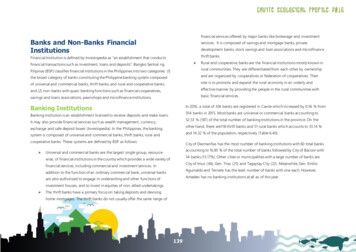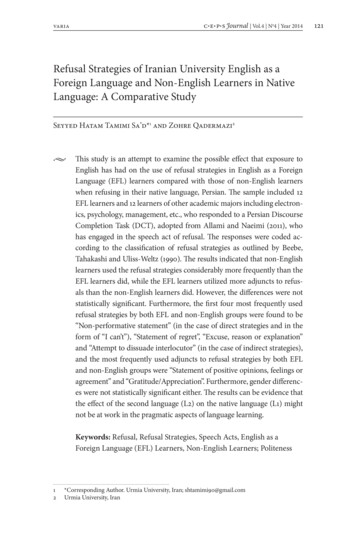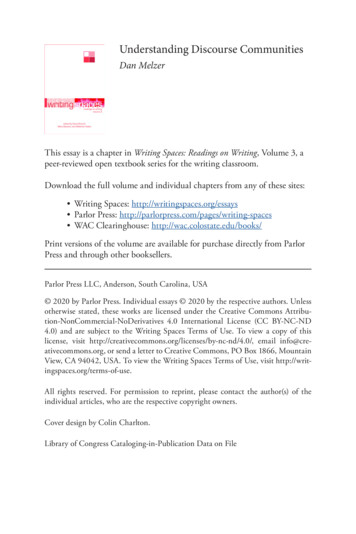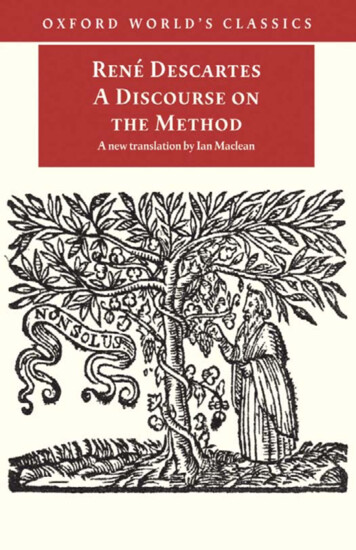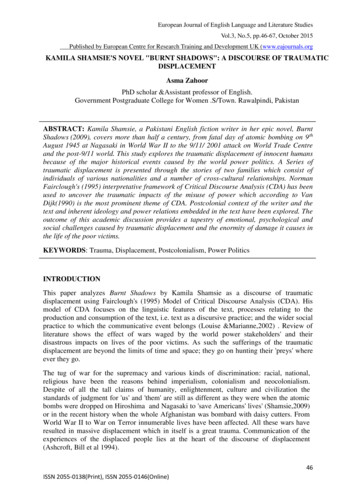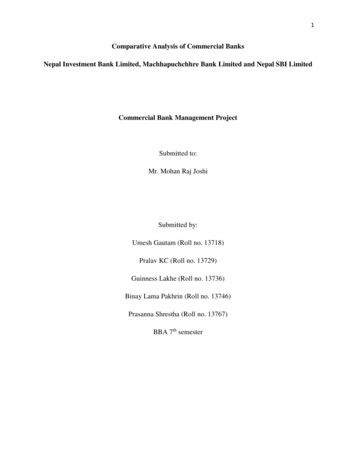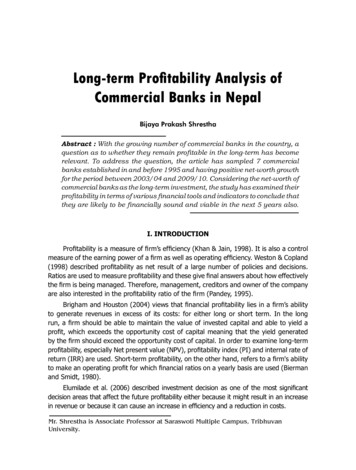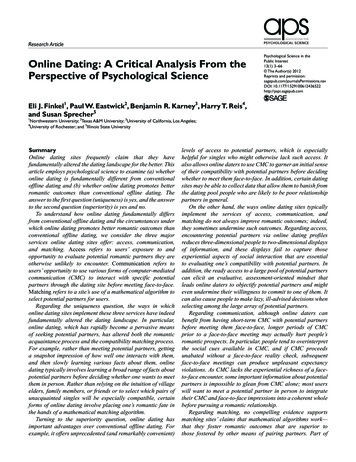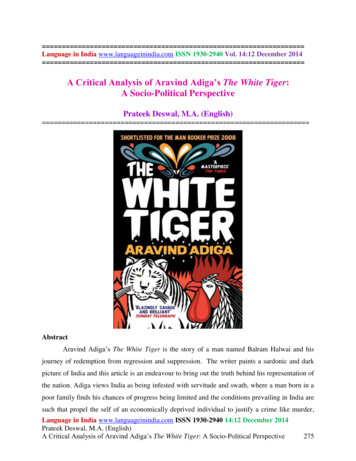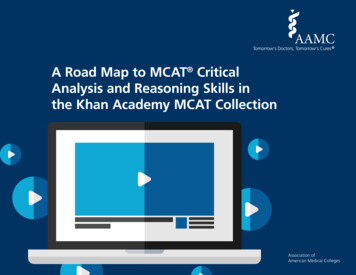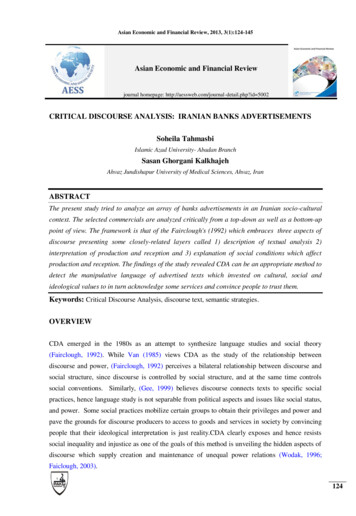
Transcription
Asian Economic and Financial Review, 2013, 3(1):124-145Asian Economic and Financial Reviewjournal homepage: http://aessweb.com/journal-detail.php?id 5002CRITICAL DISCOURSE ANALYSIS: IRANIAN BANKS ADVERTISEMENTSSoheila TahmasbiIslamic Azad University- Abadan BranchSasan Ghorgani KalkhajehAhvaz Jundishapur University of Medical Sciences, Ahvaz, IranABSTRACTThe present study tried to analyze an array of banks advertisements in an Iranian socio-culturalcontext. The selected commercials are analyzed critically from a top-down as well as a bottom-uppoint of view. The framework is that of the Fairclough's (1992) which embraces three aspects ofdiscourse presenting some closely-related layers called 1) description of textual analysis 2)interpretation of production and reception and 3) explanation of social conditions which affectproduction and reception. The findings of the study revealed CDA can be an appropriate method todetect the manipulative language of advertised texts which invested on cultural, social andideological values to in turn acknowledge some services and convince people to trust them.Keywords: Critical Discourse Analysis, discourse text, semantic strategies.OVERVIEWCDA emerged in the 1980s as an attempt to synthesize language studies and social theory(Fairclough, 1992). While Van (1985) views CDA as the study of the relationship betweendiscourse and power, (Fairclough, 1992) perceives a bilateral relationship between discourse andsocial structure, since discourse is controlled by social structure, and at the same time controlssocial conventions. Similarly, (Gee, 1999) believes discourse connects texts to specific socialpractices, hence language study is not separable from political aspects and issues like social status,and power. Some social practices mobilize certain groups to obtain their privileges and power andpave the grounds for discourse producers to access to goods and services in society by convincingpeople that their ideological interpretation is just reality.CDA clearly exposes and hence resistssocial inequality and injustice as one of the goals of this method is unveiling the hidden aspects ofdiscourse which supply creation and maintenance of unequal power relations (Wodak, 1996;Faiclough, 2003).124
Asian Economic and Financial Review, 2013, 3(1):124-145As a type of intentionally created discourse, an advertisement can instigate and manipulate viewersto exercise presuppositions that stem from the producers' particular view of the world.Circumstances of adds production has attracted CDA practitioners (Hart, 1987; Cook, 1992;Williams, 2003) to scrutinize texts critically. Fowler (1991) states that events and ideas nevercommunicate neutrality “because they are transmitted through the medium that contains certainstructural features which, in turn, are impregnated with social values that form some perspective onevents.”Statement of the ProblemMoney and investment have become complex issues in Iranian lives as concern for low income andincreasing prices have multiplied dramatically over the last thirty years in tandem with concernsabout saving and making more money. Nowadays that money and economy problems are thegreatest worry for Iranian families, advertisers do not hesitate to invest on people's need andharvest the manipulated minds. As a result, tension is expected between the effects of the wordsused in the advertising texts, and the intended meaning, which is a far cry from the endorsed words.On the one hand,although the inevitable presence of mass media and public communicationsystem magnifies the importance of discriminative reading, writing and even watching andlistening, the entanglement of discourse issues is ignored. As Foucault (1975)argues, the agenciesand individual who have the knowledge to manipulate language can control people with impunity;that’s why enormous objectives and wishes are manifested via language. On the other hand, almostall people watch TV advertisements heedlessly and may judge the overall message ofadvertisement as informative and impartial. Getting familiar with the tremendous alternation thatalluring sounds, a piece of song, a simple conversation, and some pure colors generate isprerequisite for living in a society which is interwoven with instructive discursive elements.Enlightening such perplexities is possible under CDA scrutiny, where each action receives itssuggested purpose, and each word reads its partial load. CDA could unveil the misunderstanding,biases and inspirations which color the words and frame the screens of the tube.Research Questions and HypothesesIn this research the following two research questions came out of the contemporary problems andrequirements:1.How can we detect manipulation of realities and ideologies in Banks’ commercials through theframework suggested by (Fairclough, 1992)?2.Are there mechanisms of manipulation in the discourse of Banks’ commercials? How arepurposes manifested in Banks’ commercials?125
Asian Economic and Financial Review, 2013, 3(1):124-145Critical Discourse Analysis: An OverviewThe portray that Halliday (1994) suggested for language as “social act” has united most CDAadvocates to draw an adhesive connection between the structure of language and the structure ofsociety. That is why Fowler et al. (1979) argue that the choice of grammar and vocabulary forindividuals is not arbitrary but ideologically based.Furthermore, the term discourse includes allforms of language (spoken interaction, written texts and visual texts) and practices, and since inCDA, discourse as a social practice is underscored (Wodak, 1996), the only concern is notlanguage.As Kress and Van (1990) argue CDA as an effective tool sheds lights on unequal power relationsin public discourse by showing how public discourse often serves the interests of the powerfulforces over those of the less privileged. Some social groups know how to arrange linguisticelements to affect ordinary people’s preferences. A more desperate situation is when the lay peopleunconsciously make the power distance deeper since they are not aware of the facts which are theirimmediate rights.Advertisements, either written or spoken, are discourses that may employ social power abuse,dominance, and inequality, and eventually change and maintain social practices. CDA questionsthe ongoing process of an event; how the event – e.g., bank advertising - maintains the presentsocial structure or supposedly changes or revise it (Bloor and Bloor, 2007). Almost all CDAfollowers working on advertisements argue that we may consciously or unconsciously beinfluenced or even misled by the persuasive language of advertising or persistent marketing (Gully,1996; Lunga, 2006; Woods, 2006; Bloor and Bloor, 2007). They almost believe that the study oftexts like advertising is legitimate and common for CDA to work on.Expectedly, discourse as a social practice entails disguise and fabrication.Itcan serve particularinterests, while misleading others. CDA voluntarily engages in understanding how social practicesare prone to select certain structural possibilities and then excludecertain forms(Faiclough, 2003).Such forms of selections and exclusions continue over time in advertisements. On the other hand,asShohamy (2001) as well as Pennycook (2001) (Pennycook, 2001)(Pennycook, 2001)(Pennycook,2001)(Pennycook, 2001)(Pennycook, 2001)(Pennycook, 2001)(Pennycook, 2001)(Pennycook,2001)(Pennycook, 2001)(Pennycook, 2001)(Pennycook, 2001)(Pennycook, 2001) agree, criticalstudies could be valid if make contribution to knowledge and enhance social life conditions.Whereas CDA is preoccupied with issues of power and inequity, there are critics who expect CDAto provide in-depth analysis and insights in developing countries where economic problems makepeople vulnerable to constructed discourse. To counteract that criticism, dealing with the discourse126
Asian Economic and Financial Review, 2013, 3(1):124-145of banks' advertising is a new call. Banks' advertising critical discourse analysis can offer deepinsights in the analysis of questions related to linguistic and pictorial resources.How Come Advertisements?Reviewing advertisement-related literature, one can find that adds, although short and scanty, arecomplex and interdisciplinary in nature (Woods, 2006; Bloor and Bloor, 2007). As Woods, (2006)argues, while a handful of advertisements might be informative without trying to persuade peopleto act, the inexorable aim of most advertisements is to promote the sale of some goods or services.Consequently, it is challenging for ordinary people to distinguish the persuasive advertising frominformative programs and spot the discursive elements. Due to the fact that the power of media isundeniable, it might be customary to study this issue through CDA. That is, in order to find aboutthe hidden purposes, fabricated realities, power mismatches between costumers and servers,culturally charged phrases, and eventually misinterpreted genres (Hall et al., 1980; Davis andWatson, 1983; Collins et al., 1986; Woods, 2006) a CDA look might be quite effective.As illustrated by some researchers (Nava, 1997; Williams, 2003) advertisements make use of intertextual elements and purposefully exploit familiar genres like TV shows, police serials, or specialTV programs which people follow most. In addition to exploiting persuasive elements, advertisesare explicitly aware of their target audience. They know precisely when their target audiences arewatching TV and they are told which programs and what times could embrace their means. A greatdeal of time as well as money charges the final art of advertisements to exactly identify the targetaudience. They know exactly the answers to questions of who, when and where of the costumersand how much they need a specific good or some target service.As a form of communication, (Woods, 2006) defines advertising as a common hit in a piece ofmusic or film and also the “cutting edge of modern art”. This study, assumes that nobody,including the researchers, could pretend that s/he is not mesmerized by the memorable form ofadvertisements which explicitly exploit catchphrases, catchwords, mottos and slogans and tactfullyarranged structures. Kids and even elderly people verbalize the words and phrases exploited byadvertisements and practice them in daily conversations. For example, the cutie, who performs inthe advertisements produced for Sehat Cleansing Products, is so well-known that one cannot saythe name of any of Sehat products without reminding that girl.METHODTheoretical FrameworkSifting through all the available approaches and facing with the enormous range of suggested ways,one may doubtwhich one to choose, however, the present study refers to Fairclough (1992), three-127
Asian Economic and Financial Review, 2013, 3(1):124-145dimensional framework to analyze the Iranian banking advertisement. The paper aimed to unveilthe interests embedded and problems prescribed by the copy writers in the manifestation of eachadvertisement through exploiting specific textual, discursive, and contextual features of bankingadvertisements.Embedded in the (Fairclough, 1992) three-dimensional framework are three aspects of discoursewhich present some closely-related layers called 1) description of textual analysis 2) interpretationof production and reception and 3) explanation of social conditions which affect production andreception. To describe the text as a whole, the type of the text, the sequence of the materials and theoverall layout and even visual or auditorial aspects of the text are considered. To interpret the text,the relationship perceived within different processes of the text at the level of production andreception is analyzed. The study scrutinized the discourse of advertisements with more detailswhich include items such as perspectives, presence and absence, the sounds of advertisingdiscourse, rhyme and rhythm; then for manipulation of meaning, presupposition, personalization,personification, elatives, and topicalization were detected. At the level of explanation, discursiveprocesses were analyzed to reveal the reason for choosing the particular linguistic forms andfunctions regarding the Iranian cultural, social and even historical realities; in the analyzed texts thesequences are sometimes slightly mixed or alternated to match the natural flow of ideas in the texts.Besides language, other useful tools are within the advertising reach to construct language, endorseit with lucrative and promising grammar as well as words, and finally meet the culturally-preferredand socially-decorated norms, and hence boast the success of advertised services. In this study,however, only those specific semiotic and linguistic aspects that make up the text and those whichare relevant to illustrate how power relations function, how financial problems are constructed andhow magically-fulfilling solutions would be invented were noticed; there are still other issues likeidioms, and code switching prevalent in similar adds which might be practical issues for furtherresearch.The Data and Data SourcesA corpus of 16 commercials broadcasted on Iranian national television was subjected to aquantitative analysis. The commercials were collected between 9 to 11 p.m., the time when mostpeople are watching news or family series. TV commercials are preferred to the written mediumof the press and magazines since they attract more viewers and integrate more elements toeventually convey the message and meet the purpose. That is, the latter displays certain linguisticfeatures and phonological schemes, such as rhyme (4.1.4) while in addition to this quality,television commercials, provide unique paralinguistic features, and contain a higher proportion of“block” or “disjunctive” language (Leech, 1963), hence broadcasted at specific times.All128
Asian Economic and Financial Review, 2013, 3(1):124-145television commercials used in this study ran for a
Furthermore, the term discourse includes all forms of language (spoken interaction, written texts and visual texts) and practices, and since in CDA, discourse as a social practice is underscored (Wodak, 1996), the only concern is not language. As Kress and Van (1990) argue CDA as an effective tool sheds lights on unequal power relations in public discourse by showing how public discourse often .
